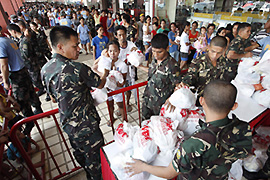Flood survivors crowd aid centres
Philippine authorities struggle to cope after tropical storm Ketsana wreaks havoc.

“More people are coming in by the hour… we don’t know how long we will be able to sustain this,” Joe Ferrer, a local government official at one of the shelters said.
“We need clothing, food supplies, food rations and medicine.”
The government has declared a “state of calamity” in Manila and 25 storm-hit provinces.
 |
| Large parts of Manila and the neighbouring areas remain submerged [Reuters] |
On Tuesday, part of the Philippine president’s official residence was opened as a relief centre for victims.
“We’re responding to the extent we can to this once-in-a-lifetime typhoon emergency,” Gloria Macapagal Arroyo, the Philippine president, said in a statement.
Ketsana dumped over a month of rain in just 12 hours on Saturday, leaving most parts of Manila and neighbouring areas submerged, in places under several metres of water.
The flooding was worst around the Pasig River that cuts through the capital, one of the world’s largest cities with a population of about 12 million.
Officials estimate losses caused by the floods to total nearly $100m and economists have said the impact of the disaster will be felt for many months to come.
Foreign governments and UN agencies have already pledged some $200m in aid.
But authorities could face more trouble as another tropical storm, Parma, is expected to become a full-blown typhoon by Friday as it passes east of the Philippines bringing more heavy rains to the area.
Lack of assistance
Al Jazeera’s Wayne Hay reporting from Arayat north of Manila said there was no sign of any government assistance or clean-up operations in the area except for some food handouts.
|
“We just floated in the water holding on to a trunk of a banana tree” Herminio Abahat, |
Our correspondent said people are very upset by the lack of assistance and have chosen to stay in their own homes despite the flooding and the risk posed by an upcoming storm.
Authorities said at least 38 people are still missing and more rains were forecast in the central region.
“What happened was the water suddenly rose,” said Herminio Abahat, whose wife went missing after they were swept into a river and separated by the raging currents.
“We did not know the water would reach the second floor so we went up to the roof but the roof gave in, and we just floated in the water holding on to a trunk of a banana tree.”
 |
| Relief shelters are struggling to cope with demand [Reuters] |
Thick mud lay in the streets in some parts of the capital while other places remained submerged, although the main downtown business and tourist district was largely unscathed.
In Marikina district just outside of Manila, police used forklifts to remove mud-caked cars stalled along roads.
Victims lined up for hours at relief centres for bottled water, boiled eggs and packets of instant noodles.
Gingery Comprendio, a mother of five, described how she left her children on the roof of their house to alert the authorities, only to find them gone when she returned.
“I did not know what transpired. We were on top of a roof but we got separated,” said Comprendio, whose husband is missing.
“The next day when I came back to our house I saw my eldest already dead and my aunt saw my other child buried in the mud.”